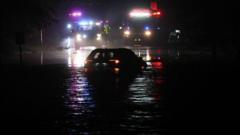What Caused the Deadly Flash Flooding in New Jersey and NYC?

Understanding the Impact of Torrential Rains and Flash Flooding in New York and New Jersey
The recent torrential rains that struck New York and New Jersey have left a devastating mark, resulting in tragic fatalities and widespread destruction. As communities grapple with the aftermath, officials are working tirelessly to manage the crisis and mitigate further risks. This article delves into the details of this weather event, its implications, and what residents should do to stay safe in future storms. We will explore the causes of such extreme weather, the response from local authorities, and broader implications for climate patterns.
The Severity of the Storm
On Monday night, New York and New Jersey experienced unprecedented rainfall that led to flash flooding and tragic loss of life. With New Jersey Governor Phil Murphy declaring a state of emergency, it became evident that the situation was dire. Here are key highlights of the storm's impact:
- Two fatalities were reported in Plainfield, New Jersey, where floodwaters swept away a vehicle.
- Numerous rescues were conducted as drivers became stranded in rising waters.
- New Jersey recorded over 6 inches (15 cm) of rain in just a few hours.
- New York City reported its second-highest hourly rainfall in over 80 years, with 2 inches falling in just 30 minutes.
- Transportation systems were severely affected, with subway delays and road closures reported.
Understanding Flash Flooding
Flash flooding occurs when heavy rainfall overwhelms drainage systems and natural waterways. This phenomenon can happen rapidly, often with little warning, making it particularly dangerous. Factors contributing to flash flooding include:
- Soil Saturation: If the ground is already saturated from previous rainfall, additional rain cannot be absorbed, leading to runoff.
- Urbanization: Cities with extensive impervious surfaces, such as roads and buildings, experience faster runoff, exacerbating flooding.
- Topography: Low-lying areas are more prone to flooding, particularly during torrential rains.
Local Response and Rescues
In the face of such calamity, local emergency services sprang into action. Rescues were prioritized, with responders employing various strategies to save stranded individuals. For instance, in Scotch Plains, first responders used ropes to pull a man out of his vehicle, highlighting the dangers and challenges faced by those caught in the floodwaters.
Infrastructure Challenges
The heavy rains caused widespread infrastructural challenges, impacting transportation and public services:
- Road Closures: Several main roads in New Jersey were closed due to flooding, making travel hazardous.
- Public Transit Delays: New York City's subway system saw significant delays as floodwaters rushed through stations, forcing passengers to adapt to the conditions.
- Flight Disruptions: Newark Liberty International Airport experienced delays and cancellations, affecting countless travelers.
Future Weather Patterns and Forecasts
According to the National Weather Service (NWS), additional storms were expected to hit the region on Tuesday, potentially leading to further flooding not just in the Northeast, but also in areas like Florida and the Midwest. As the NWS encourages residents to heed road closures and stay informed, it raises questions about the future of weather patterns in the context of climate change.
Climate Change and Extreme Weather
The increasing frequency and intensity of extreme weather events have become a pressing concern as discussions around climate change intensify. Here are some key points to consider:
- Increased Rainfall: Studies indicate that a warming atmosphere can hold more moisture, leading to heavier precipitation during storms.
- Rising Sea Levels: Coastal flooding is exacerbated by rising sea levels, increasing the risk of flash floods in coastal cities like New York.
- Urban Heat Islands: Cities tend to retain heat, which can amplify storm intensity and rainfall patterns.
Safety Measures and Preparedness
As the risk of flash flooding remains a concern, individuals and communities must prioritize safety and preparedness. Here are essential steps residents can take:
Before a Storm
- Stay Informed: Monitor local weather forecasts and alerts from the NWS.
- Emergency Kit: Prepare an emergency kit including food, water, medications, and important documents.
- Evacuation Plan: Have a plan in place for evacuation if necessary, including routes and destinations.
During a Storm
- Stay Indoors: If possible, remain indoors during severe weather.
- Avoid Floodwaters: Do not attempt to drive or walk through flooded areas.
- Heed Warnings: Follow instructions from local authorities and emergency services.
After a Storm
- Assess Damage: Carefully evaluate the situation and report any hazards to the authorities.
- Seek Help: If you are affected, seek assistance from local relief organizations.
- Document Losses: Take photos of any damage for insurance claims.
Looking Ahead
The recent flooding in New York and New Jersey serves as a stark reminder of the power of nature and the importance of preparedness. As more storms are forecasted, communities must remain vigilant and proactive in their safety measures. The impact of climate change further complicates the situation, necessitating a collective response from individuals, governments, and organizations to mitigate risks and bolster resilience.
Frequently Asked Questions (FAQs)
What should I do if I'm caught in flash flooding?
If you find yourself in a flash flood, seek higher ground immediately. Avoid driving through flooded areas and stay informed about local emergency services and evacuation routes.
How can I prepare my home for potential flooding?
Consider elevating electrical appliances, sealing basements, and creating a flood emergency kit. Additionally, familiarize yourself with local flood zones and evacuation routes.
What are the signs of an impending flash flood?
Signs include a sudden increase in rainfall, rapidly rising water levels, and changes in water color. If you notice these signs, seek higher ground immediately.
As we witness the implications of extreme weather events, it’s crucial to engage with our communities and advocate for sustainable practices to combat climate change. How prepared is your community for future weather challenges? #FloodSafety #ClimateAwareness #EmergencyPreparedness
Published: 2025-07-15 15:10:20 | Category: world



